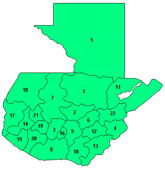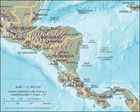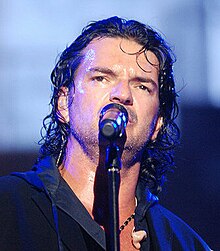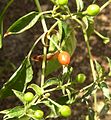The Guatemala portal
Republic of Guatemala República de Guatemala (
Spanish) | |
|---|---|
Motto:
| |
| Anthem: Himno Nacional de Guatemala (English: "National Anthem of Guatemala") | |
| ISO 3166 code | GT |
Guatemala, officially the Republic of Guatemala, is a country in Central America. It is bordered to the north and west by Mexico, to the northeast by Belize, to the east by Honduras, and to the southeast by El Salvador. It is hydrologically bordered to the south by the Pacific Ocean and to the northeast by the Gulf of Honduras.
The territory of modern Guatemala hosted the core of the
Maya civilization, which extended across
Mesoamerica; in the 16th century, most of this was
conquered by the Spanish and claimed as part of the
viceroyalty of
New Spain. Guatemala attained independence from Spain and Mexico in 1821. From 1823 to 1841, it was part of the
Federal Republic of Central America.
For the latter half of the 19th century, Guatemala suffered instability and civil strife. From the early 20th century, it was ruled by a series of dictators backed by the
United States. In 1944, authoritarian leader
Jorge Ubico was overthrown by a pro-democratic military coup, initiating
a decade-long revolution that led to social and economic reforms. In 1954,
a US-backed military coup ended the revolution and installed a dictatorship.
From 1960 to 1996, Guatemala
endured a bloody civil war fought between the US-backed government and
leftist rebels, including
genocidal massacres of the Maya population perpetrated by the Guatemalan military. The
United Nations negotiated a peace accord, resulting in economic growth and successive democratic elections.
Guatemala's abundance of biologically significant and unique ecosystems includes many endemic species and contributes to Mesoamerica's designation as a
biodiversity hotspot.
Although rich in export goods, around a quarter of the population (4.6 million) face
food insecurity. Other extant major issues include poverty, crime, corruption, drug trafficking, and civil instability.
With an estimated population of around 17.6 million,0 Guatemala is the most populous country in Central America, the 4th most populous country in
North America and the 11th most populous country in the
Americas. Its capital and largest city,
Guatemala City, is the most populous city in Central America. (
Full article...)
Selected article -
In 1994 Guatemala's Commission for Historical Clarification - La Comisión para el Esclarecimiento Histórico (CEH) - was created as a response to the thousands of atrocities and human rights violations committed during the decades long civil war that began in 1962 and ended in the late 1990s with United Nations-facilitated peace accords. The commission operated under a two-year mandate, from 1997 to 1999, and employed three commissioners: one Guatemalan man, one male non-national, and one Mayan woman. The mandate of the commission was not to judge but to clarify the past with "objectivity, equity and impartiality."
Among other things, the commission revealed that over 200,000 people were killed or disappeared during the conflict and attributed 93% of the violations to state forces and related paramilitary groups. The commission noted that during the conflict the distinction between combatant and non-combatant was not respected and as a result many children, priests, indigenous leaders, and innocent women and men were killed. The CEH aimed to instill national harmony, promote peace, foster a culture of mutual respect regarding human rights, and preserve the memory of the conflict's victims. ( Full article...)Did you know (auto-generated)

- ... that the Central American government voted for annexation to the First Mexican Empire after a request from Regent Agustín de Iturbide?
- ... that the Adelaide L. T. Douglas House, built for a New York City socialite, housed the United States Olympic Committee before being sold to Guatemala?
Subcategories
WikiProjects
Edgar Ricardo Arjona Morales (born 19 January 1964), known as Ricardo Arjona (Spanish pronunciation: [riˈkaɾðo aɾˈxona]), is a Guatemalan singer and songwriter. He is one of the most successful and best-selling Latin American artists of all time, with more than 20 million records sold. He is often called El bajito de sal (The low in salt), thanks to his breakthrough success with his fourth studio album, which bears the same name. His music ranges from ballads to Latin pop, rock, pop rock, Cuban music, and more recently a cappella performances and a mixture of Tejano music and Norteño music, and Latin sounds. Arjona is noted for his lyrical style, and often addresses topics such as love, sexuality, violence, racism and immigration.
As of 2016, Arjona had released sixteen studio albums, one live album, nine compilation albums and forty-three singles. Four Arjona albums reached number one on the Billboard Top Latin Albums, and ten reached number one in Argentina. Four albums had charted on the Billboard 200. Four singles had reached number one on the Billboard Latin Songs chart and seven had done the same on Latin Pop Songs. His work earned him numerous awards and accolades, including one Grammy Award, one Latin Grammy Award, the Latin Heritage Award as well as awards from the American Society of Composers, Authors and Publishers; a silver and golden torch and two silver seagulls from the 2010 Viña del Mar International Song Festival, two Billboard Latin Music Awards, and a "Latin Trajectory of the Year" Award at the Orgullosamente Latino Awards of 2010. ( Full article...)Selected image -
More did you know -
- El Mirador was by far the most populated city in Pre-Columbian America and contains the second largest pyramid in the world by volume.
El Señor Presidente (Mister President) is a 1946 novel written in Spanish by Nobel Prize-winning Guatemalan writer and diplomat Miguel Ángel Asturias (1899–1974). A landmark text in Latin American literature, El Señor Presidente explores the nature of political dictatorship and its effects on society. Asturias makes early use of a literary technique now known as magic realism. One of the most notable works of the dictator novel genre, El Señor Presidente developed from an earlier Asturias short story, written to protest social injustice in the aftermath of a devastating earthquake in the author's home town.
Although El Señor Presidente does not explicitly identify its setting as early twentieth-century Guatemala, the novel's title character was inspired by the 1898–1920 presidency of Manuel Estrada Cabrera. Asturias began writing the novel in the 1920s and finished it in 1933, but the strict censorship policies of Guatemalan dictatorial governments delayed its publication for thirteen years. ( Full article...)List of Featured articles
|
|---|
Topics
Departments
Guatemala is divided into 22 departments (departamentos) and sub-divided into about 332 municipalities (municipios).
The departments include:

Related portals
Things you can do

Here are some things you can do for WikiProject Guatemala:
-
Create requested articles:
- El Viejo Palmar -- Village south of Quetzaltenango, hit by a volcanic eruption
- Expand "stub" and "start" articles:
- Assess the importance of articles:
Recognized content
| This is a list of recognized content, updated weekly by JL-Bot ( talk · contribs) (typically on Saturdays). There is no need to edit the list yourself. If an article is missing from the list, make sure it is tagged (e.g. {{ WikiProject Guatemala}}) or categorized correctly and wait for the next update. See WP:RECOG for configuration options. |
Featured articles
Good articles
- 5to Piso
- 2010 Guatemala City sinkhole
- Adentro
- Gómez de Alvarado
- El Amor (Ricardo Arjona song)
- Francisco Javier Arana
- Jacobo Árbenz
- Ricardo Arjona
- La Blanca, Peten
- Bartolomé de las Casas
- Central America under Mexican rule
- Como Duele (Ricardo Arjona song)
- El Chal
- Fuiste Tú
- Guatemala at the 2016 Summer Paralympics
- Guatemalan Revolution
- Haʼ Kʼin Xook
- Independiente (Ricardo Arjona album)
- Itzam Kʼan Ahk II
- Iximche
- Kʼinich Yat Ahk II
- Kʼinich Yoʼnal Ahk I
- Manche Chʼol
- Marta (Ricardo Arjona song)
- Mi Novia Se Me Está Poniendo Vieja
- Mixco Viejo
- Motul de San José
- Mundo Perdido, Tikal
- North Acropolis, Tikal
- Poquita Ropa
- Puente (song)
- Quién Dijo Ayer
- Quién (Ricardo Arjona song)
- Quiero (Ricardo Arjona song)
- Battle of Roatán
- Simplemente Lo Mejor
- Spanish American wars of independence
- Spanish conquest of Yucatán
- Spanish conquest of the Maya
- Te Quiero (Ricardo Arjona song)
- Tikal
- Trópico (Ricardo Arjona album)
- Vida (Ricardo Arjona song)
- White-lipped peccary
- Yoʼnal Ahk III
- Zaculeu
Featured pictures
-
Cinnamon hummingbird (Amazilia rutila) in flight Los Tarrales
-
Emerald swift (Sceloporus malachiticus) Finca El Pilar
-
Ocellated turkey (Meleagris ocellata) male Peten
Associated Wikimedia
The following Wikimedia Foundation sister projects provide more on this subject:
-
Commons
Free media repository -
Wikibooks
Free textbooks and manuals -
Wikidata
Free knowledge base -
Wikinews
Free-content news -
Wikiquote
Collection of quotations -
Wikisource
Free-content library -
Wikiversity
Free learning tools -
Wikivoyage
Free travel guide -
Wiktionary
Dictionary and thesaurus
Guatemala news
The current date and time in Guatemala is Monday, June 10, 2024, 18:12.
News media:
- The Guatemala Times
- La Prensa Libre (in Spanish)
- Wikinews Guatemala portal































































